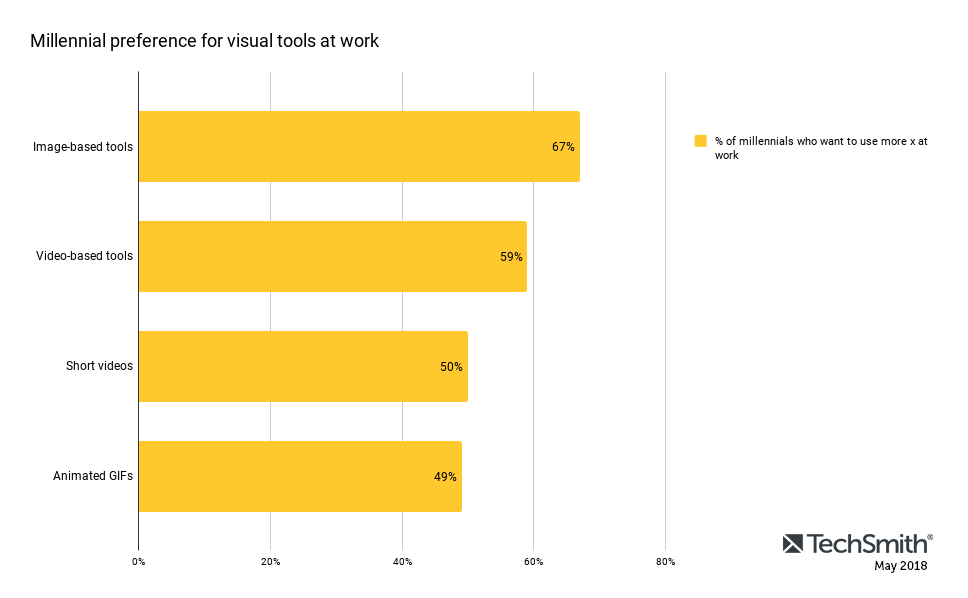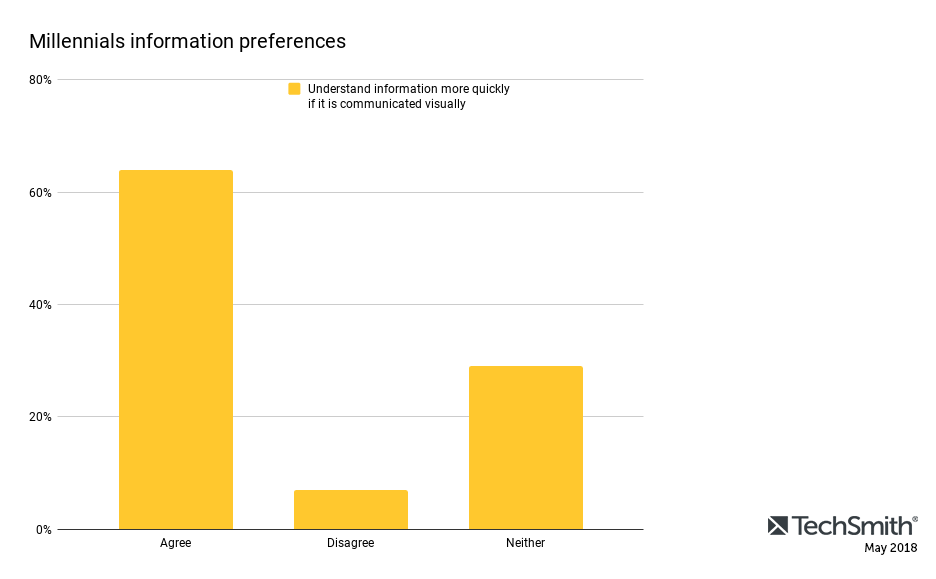Poor visual communication affecting business morale and productivity
- Written by Chloe Fitzgerald

YOUR COMMUNICATIONS TO MILLENNIALS IS FAILING
New research reveals failing to focus on visual communication threatens productivity and engagement levels
Many Australian businesses are failing with their communications to the largest generation in the workforce – millennials – and it’s affecting morale and productivity. New research by software company TechSmith, finds:
- Millennials are twice as likely to want to use more visual communications methods at work compared to baby boomers
- Businesses are falling short, with 44% of millennials believing their company's communications are outdated
- New scientific research reveals poor visual communications threaten productivity and engagement levels — not just with millennials, but with workers of all ages.
- One in two Australians say they would understand information more efficiently at work if their company increased visual communications
The research, which surveyed 4,500 office workers across six countries, including 500 Australian office workers, reveals that younger workers prefer communications with more visual content — such as screenshots, screencasts, images, gifs, and short videos — when compared to other generations in the workforce.
Millennials are twice as likely as Baby Boomers to use images and video to communicate in their own time outside of work (58% vs. 28%). And they are twice as likely to want more visual communications at work (43% compared to 19%).
Australian employees were one of the most progressive workforces surveyed, with video communication and collaboration in the workplace being most called for by Australians compared with other countries that participated in the study.
The study also found the Australian workforce placed a strong focus on work-based social networks, with 26% of Aussie companies investing in these channels over the last few years, compared with only 16% in the United States.
Wendy Hamilton, CEO at TechSmith, comments:
“Social platforms like Facebook and Instagram, which rely heavily on visual content for engagement, are the go-to way of connecting outside of work because this is how people prefer to communicate. Not only that, using images, screencasts and videos in workplace communications makes it easier to get a message across clearly and concisely.
“With millennials making up the largest generation in the workforce and Generation Z now moving through organisations too, it’s time leaders sat up and adapted to their new, image-hungry audiences.”
Despite these findings, the research also shows that most employees believe their workplaces focus heavily on text-only email for internal communications. In fact, 47% of millennials say their company relies on plain-text email to communicate, with 44% saying their company's communications are outdated.
Other key findings confirm the demand for more visual content:
- 67% of millennials want to use more image-based tools at work
- 60% want to adopt video tools
- 50% are keen to watch more short videos
- 49% want to see more animated gifs used in the workplace
Only 30% of Australian employees believe they have access to the tools to communicate effectively in their role, showing a real opportunity for businesses to boost productivity by communicating better and faster with their employees.
The research shows outdated communication has real-world consequences, sometimes leading to poor motivation and morale. Despite spending fewer years in the workforce, millennials are more likely than other generations to have been demotivated by poor company communications (43% compared to 35% of Gen X and 27% of baby boomers).
Adding visual content to company communications can sound daunting, especially for those who are new to creating images and video, there are a number of simple ways to get started.
Wendy Hamilton, CEO at TechSmith, comments:
“If you’re new to creating visual content, the key is to start small. Don’t overwhelm yourself or your employees by requiring all messages to include visuals. You could start by taking screenshots and marking them up to show changes you’d like to see on the company website, or make a short screencast video of how to access your new online HR system, etc. As you learn how simple it can be, I think you’ll find an organic and natural path to discovering how visuals can help your business better communicate.”
Here comes the science
Businesses that fail to unlock the value of visual communications seriously risk holding back productivity and engagement levels.
New scientific research reveals that communications that include visual content such as screenshots, screencasts, or videos are better, faster and more engaging than plain text for nearly all employees — not just millennials.
- Two-thirds (67%) of employees are better at completing tasks when information includes text with images or video than by communications featuring text alone.
- What’s more, employees absorb information 7% more quickly when they are communicated with using text with static images than when provided only with text.
- Overall, companies would see an 8% improvement in accuracy by using text coupled with visuals – and a 6% improvement by using video.
Wendy Hamilton, CEO at TechSmith, comments:
“When compounded per employee over every hour of every work day, the time and productivity that can be saved by communicating visually truly begins to add up.”
Dr. Alastair Goode, who led the scientific research, adds:
“More than half the human brain is involved in visual processing so visuals play a huge role in our ability to communicate. This research shows that, in a business scenario, visual communication prompts a deeper level of understanding and a more engaging experience for audiences.”
“With our propensity for visualization, it is no surprise that infographics, screenshots, screencasts, gifs, and short videos have become so popular — and also means people are becoming more accustomed to absorbing information visually than ever before.”
The complete research findings can be found at: https://www.techsmith.com/blog/research-reveals-millennials-communication-needs/
ABOUT TECHSMITH CORPORATION
Founded in 1987, TechSmith Corporation provides practical business and academic software products that can dramatically change how people communicate and collaborate. Its mission is to empower people to create remarkable videos and images that help share knowledge and information. TechSmith enables users to work more effectively wherever they may be and ensures that the process of creating, sharing and collaborating around content is simple and intuitive so that others can learn from their knowledge. Learn more at https://www.techsmith.com/ and follow @TechSmith on Twitter for the latest news.
ABOUT THE RESEARCH
The scientific laboratory test was conducted amongst 125 office workers in January 2018 by an award-winning doctor in behavioural economics, Dr. Alastair Goode.
Participants were asked to complete three everyday office tasks:
- Uploading a post to a website
- Downloading new software
- Filling in their expenses forms
For each task, one-third of the test subjects were communicated with at random by:
- Plain text (for example a text-only email)
- Text with static images (for example an email with text and annotated screenshots of the tasks)
- Video (for example a recorded walkthrough of the task with voiceover)
Participants were measured scientifically on their understanding, recall and speed, and the results for each type of communication were compared. Participants were also examined on their engagement levels and questioned on ease-of-use.
The business research surveyed 4500 office workers across six countries/regions in December 2017, including - Australia (500), Canada (500), DACH region (1,000), France (500), UK (1,000), US (1,000).
The generational data was analysed according to age and gender (split by generation: Before 1928, 1928 - 1945, 1946 - 1964, 1965 - 1980, 1981 - 1997).













